- Thursday July 4, 2024
-


AND WE DID IT TOGETHER: We’ve captured so many great photos of staff working together to make Go-Live a success. Check out the RJH Go Live Flickr album. Thank you to each and every one of you who paused for a photo during your busy workday.
Message to staff from your site leaders
We wanted to take a moment and recognize what we have accomplished together over these past few weeks.
We feel very grateful to have been in the position to lead such an amazing team of people. It’s been a huge learning journey seeing this big operational change implemented. What really rings true is that it’s a team effort in every sense of the word – not just here at RJH but also drawing on support from across Island Health. Every part of the organization has been touched by this change and contributed to how well it’s gone. Seeing people show up and be so supportive of each other with such positivity for this change inspires a lot of confidence in how we can grow and lead as an organization in the future.
Remember, even weeks after Go-Live, it’s still someone’s first day using the new system. Making the full transition to this new way of working takes time. Be patient with your peers and patient with yourself. We’re still in early days and it’s going to take a while for things to be exactly what we want them to be for the optimal efficiency. Be patient also with the project team that’s working through those fixes for us.
We are also grateful that many of you are eager to “pay it forward” to our colleagues at VGH, South Island Surgical Centre and Gorge Road Health Centre as they gear up for round two of this activation – Gillian, Hayley, Chloe and co., we will be there with you!
Finally, we are humbled and inspired by your continued engagement and professionalism and your understanding of why we’re doing this. As we are already seeing with the immediacy and fullness of information available to our care teams, we are at a new beginning – opening up greater possibilities for improving safety, quality and patient-centred care for the people we serve.
Go-Live support transitions after July 7
We have been working with computerized provider order entry (CPOE) at Royal Jubilee Hospital (RJH) for just over three weeks now. Calls for support have dropped in number. This is a sign that many of our clinical team members are adapting to the new CPOE functions and workflows.
As planned, this week we begin the transition to the next phase of Go-Live: stabilization and sustainment.
How to access 24/7 support now and after July 7:
The 24/7 IHealth Central Support line will end on Sunday, July 7 at 2400 hours, and support will transition to the Clinical Service Desk. Going forward, please use the following:
Until July 7 at 2400 hours, call IHealth Central Support line at 1-855-755-7001. From July 8, call Clinical Service Desk at 18777 option 3 (or 250-370-8777 option 3). Click the “Band-Aid” support widget at the top of your device screen to access the IHealth Cerner Wiki. Look for a member of ProEX support team rounding on your unit or floor. Visit the Engagement Lab in Royal Block Room 203, Monday-Friday, 0700-1500, with support staff to help you practice and answer your questions.
Dedicated stabilization support will be arranged for the following areas: Heart Health, Adult ICU, CVU, CCU, Perioperative and Emergency Department (ED).
Read the IHealth daily key messages
Pink socks a hit during Go-Live
Bright pink socks featuring EHRin, IHealth’s cheery ‘Goodwill ambassador’, have been a big hit with staff and providers during Go-Live. The idea for brightly coloured socks originally came from a nurse on break when the communications team was doing a site visit a few months before Go-Live.
The IHealth team procured a limited run of the custom socks to thank staff at IHealth-activating sites who offer us their perspectives in interviews and quotes, appear in photos, and generously provide enthusiastic support. The socks are made by a company that donates three pairs to charity for every pair purchased. We’ll be bringing more socks to Go-Live at Victoria General Hospital, Gorge Road Health Centre and South Island Surgical Centre in September.
For those lucky enough to get a pair, enjoy them, and we hope they help when you can finally put your feet up for a post-Go-Live rest!
Quick Survey
We’d love your feedback and ideas!
We’ve published 15 issues of RJH Go-Live News since the “night before Go-Live” on Friday, June 7. We would love your feedback and ideas so we can make improvements when we move on to other sites, including Victoria General Hospital, South Island Surgical Centre and Gorge Road Health Centre in September.
Please take a minute and complete this short survey.
Key Links
- Thursday June 27, 2024
-

Lightening the Paper Load: The switch from paper to electronic ordering reduces the amount of paper flowing across Royal Jubilee Hospital. With CPOE and electronic clinical documentation both activated at RJH, patients benefit from having their patient information in a single electronic record, and care providers can more easily see and share the information they need to support the best care decision
‘You don’t know what you don’t know until you get going with it’

Andrea Tabaka, Speech Language Pathologist
In her role as Practice Support for Speech Language Pathology, Andrea Tabaka had to become adept with computerized provider order entry (CPOE) ahead of her peers at Royal Jubilee Hospital (RJH), Victoria General Hospital and Gorge Road Health Centre. That’s because it was Andrea’s job to teach Speech Language Pathologists (SLPs) how to use the new workflows in the electronic health record (EHR) in preparation for the CPOE Go-Live. Following her training in March and April, Andrea, also an SLP, has provided all the workflow sessions for SLPs working at these sites, working closely with Christine Neufeld and Bailey Toupin in Clinical Informatics.
Regarding the Go-Live at RJH, Andrea is up-beat. “Everyone is feeling good about it. Just like anything, you don’t know what you don't know until you get going with it,” she says. “We did the practice sessions, which I think were helpful, but now that they’re getting to use those skills in practice, I think it’s making more sense.”
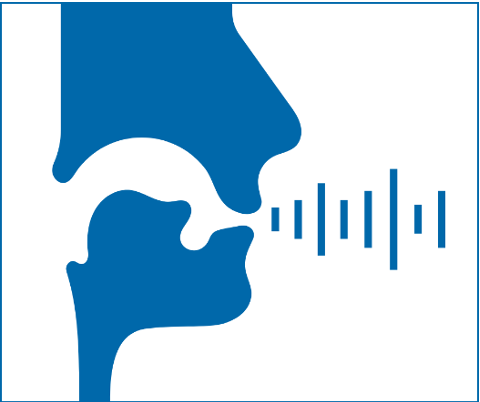
One of the challenges with CPOE rollout has been that although Nanaimo Regional General Hospital has been using CPOE for years, some of the processes are slightly different for each site. The SLPs, Clinical Informatics and Food Services team were able to collaborate to find a workflow solution that worked for the South Island.
Preparing herself and her colleagues for the change has been an intense focus of Andrea’s work for the last few months, taking up 10 to 20 hours a week apart from her usual practice support duties. “It’s only me – I’ve been the one doing everyone’s education since March, so honestly after everybody is up and going, I’m going to be very excited.”
“This a big change for the hospital system. Everyone, for the most part, has been really understanding with each other, which has been helpful. Once everyone is online it’s going to make it that much easier for patients to transfer between hospital sites and Nanaimo.”
Streamlined success: CPOE enhances Pharmacy efficiency and patient care
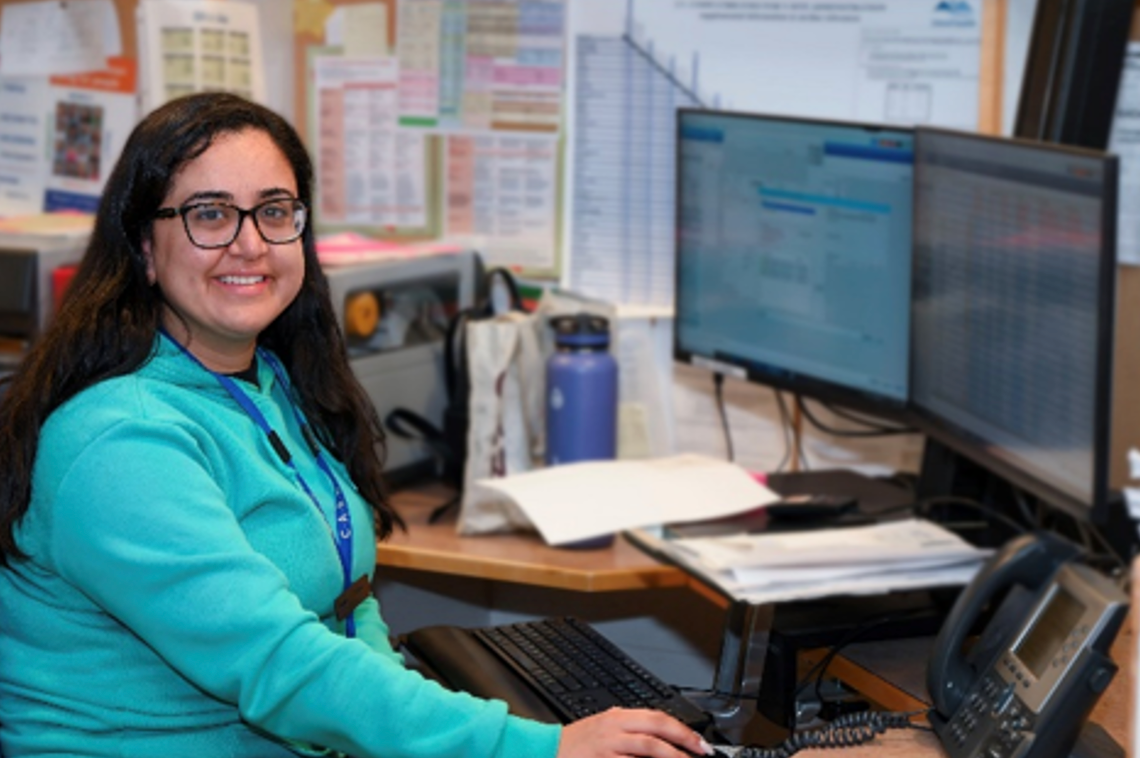
Pharmacist Jasleen Dhatt now verifies medication requisitions using PowerChart
As a department that touches almost every patient in the hospital, the Pharmacy team has seen significant changes to their workflows and improved access to patient information available with CPOE implementation.
Before the change, prescriptions were manually written on paper, scanned and sent to the pharmacy, where pharmacy technicians entered the information into the EHR. It was a labor-intensive process involving multiple steps by pharmacists and pharmacy technicians to ensure medication accuracy.
With CPOE, orders are now placed in the EHR directly from the ward, allowing real-time verification by the Pharmacy team.
“The biggest benefit is that we are not checking transcription anymore,” says Clarene Ho, RJH Pharmacy Site Coordinator. “We can now focus fully on what is clinically appropriate for the patient.”
Between June 8, when the system went live, and June 26, Pharmacy had processed a whopping 63,254 electronic orders!
Improved access to the Medication Administration Record (MAR) is another advantage. “Now that we can see the MAR, it helps us make informed clinical decisions more quickly because we have more information available to us in real-time regardless of our location,” notes Dr. Sean Spina, Regional Clinical Pharmacy Manager.
The transition to CPOE has not been without challenges as the Pharmacy team adapts to the new system and workflows alongside physician and nursing teams. However, with teams on-site seven days a week to address issues, they’ve been able to respond quickly.
In addition to the new CPOE workflows, the Pharmacy team is also adapting to new technology that’s replacing their 19-year-old distribution robot. “I want to give a shout-out to my Pharmacy team,” says Clarene. “It’s been a lot all at once, to learn these new workflows at the same time as the IHealth workflows. But the team has been adapting really well.”
Read the IHealth daily key messages
Spotlight Q&A

Name: EHRin
Role: IHealth goodwill ambassador
Previous activations: This is my first Go-Live, but I was very active at the IHealth World Cafés starting last fall. I have deep experience in bringing a lot of different people together!
How it’s going: I feel like I'm everywhere, all the time! I’m on stickers, tote bags, lanyard cards, cleaning cloths, even those popular pink socks! My favourite place to hang out, though, is in the windows of the PCC Atrium.
What are you most proud of? The staff! They have worked SO hard to get here, and they should be very proud of how well they are doing and how much they have accomplished.
Activity looking forward to on days off: What days off? I am here for the whole Go-Live, to put a smile on people’s faces, then it’s over to Victoria General Hospital, South Island Surgical Centre and Gorge Road Health Centre in September. It's a good thing that we cartoon ambassadors are known for our boundless energy.
Tip: When you see me, stop and think, “By working in the EHR, I am making a WORLD of difference for our patients.” Because you are.
Support at the elbow, on the desktop and remote
Find support when and where you need it during Go-Live. If you need help or have a question, reach out 24/7 to support staff on your unit, use the “Band-Aid” tool at the top of your screen to get help, or call IHealth Central Support at 1-855-755-7001 or 28555.
Key Links
- Tuesday June 25, 2024
-
Three Heart Health units take a deep dive into electronic health records
The Go-Live team effort in Heart Health included RNs Elyse Sidhu and Teresa Hanna (l-r: left photo) in Cardiac Short Stay, and cardiovascular technologists Matthew Jai and Ricky de Silva (l-r: right photo) in the Electrophysiology unit.
Three cardiac care units that provide tertiary services for all of Island Health went live not only with computerized provider order entry (CPOE), but also with electronic clinical documentation and best possible medication history (BPMH) starting Monday, June 10. The complex Go-Live meant hours of training for staff, and a steep learning curve, but careful planning and a team effort were paying dividends by the end of the second week.
In the fast-paced Cardiac Short Stay clinic, where a nurse typically cares for three patients at once, they temporarily doubled the ratio, with two nurses caring for three patients. Even so, RN Teresa Hanna felt the effect of the steep learning curve at the computer.
“Last week I said to my patient, ‘I'm really sorry, I would normally have asked you how many kids you have by now, all those things.’ But at the moment, there's just no time for that,” says Teresa.
“What's beneficial is that there will eventually be a lot of routine. Once you've done a pacemaker or an arterial recovery band 10 times or even three times, it starts to become not so onerous. The first time was like ‘Oh my god,’ and the third time was like ‘Oh this is great!’”
In the Electrophysiology unit, cardiovascular technologist (CVT) Ricky de Silva is feeling confident with the new tools.
“I'm trying to find some more questions to ask,” Ricky says with a twinkle in his eye. “I'm always trying to test the limits of what you guys know.”
In the Catheterization Lab, CVT Alyssa Nguyen monitors and manages patients using several screens, and now has an additional screen displaying PowerChart.
“It’s a good resource to have on hand when we’re referencing patient history, and as well, the medications are easy to navigate and find pertinent information that we may not have had access to otherwise,” says Alyssa. “It's a benefit for patients coming between hospitals where maybe a piece of paper didn’t come along with the charts.”
Cardiologist Dr. Anthony Della Siega is pragmatic about the necessary balance between learning prior to Go-Live and on-the-job experience. “It’s been okay for us -- I knew that we were just going to have to get into it, muddle through and figure it out.”
HCL/EP and Cardiac Short Stay Manager Krista Mann glows when asked about the work put in by the teams on these units. “Not only have the teams embraced CPOE and BPMH, but the electronic documentation is also completely new for them. They have met this enormous challenge with professionalism, grace, and such incredible kindness and compassion towards each other that I can’t put into words how proud I am to be their manager.”
Heart Health teams at RJH made the full change to both electronic clinical documentation and electronic ordering (CPOE) on June 10. From top left: the Electrophysiology Lab team, the Cardiac Catheterization Lab team, and the Cardiac Short Stay team.
RJH ambassador thrives in role offering warm welcome and encouragement

Sarah Saeed Khan is a friendly face and a warm smile that staff, patients and visitors can count on when they’re arriving at Royal Jubilee Hospital (RJH).
As one of the RJH ambassadors stationed in main entrances to the facility, Sarah spends her days dispensing directions, checking in with staff who she’s come to know over the past one and a half years on site, and offering a warm and gracious welcome.
She has been keenly aware this month that staff are undergoing a significant change to their work with Go-Live for electronic ordering underway.
“The ones I talked with before they began their courses, they were apprehensive,” she says. “Then, the nurses I’ve talked to, once they get into using the program, they’re really surprised at how smooth it runs, and they get the support they need.”
Sarah gets to know patients and families as they move through the site and has heard them mention the importance they place on privacy and security of their health information.
“That’s a biggie with patients,” she says, adding she is aware the Cerner system provides greater security for patient information. “It’s good to see the hospital moving in that direction with electronic records.”
Sarah brings years of experience as a medical office assistant to her ambassador role, where she works between four and five days a week at RJH, with the occasional shift at the Esquimalt UPCC.
At 82, she enjoys the people and pace of the work – and, when it’s the right moment and she has their permission, loves offering encouragement and giving hugs to people who need them.
It’s a quick answer when she’s asked what she feels is the most important quality an ambassador brings to their role. “I’m hoping it’s cheerfulness,” she says.
“It’s making their visit at the hospital a pleasant one, because whoever is coming to the hospital at any time, whether as a patient or a visitor, it’s not always the best,” she says. “So if you can make it a little more pleasant for people, for somebody, give them a smile, give them a greeting, I think that goes a long way.”
Read the IHealth daily key messages
Spotlight Q&A

Name: Daniel Chen
Role: Provider Education and Experience physician engagement specialist
Previous activations: None – this is the first
How it’s going: In the beginning the questions were more general but now they’re more specific and specialized.
Activity looking forward to on days off: The gym. After this stressful week I’m going to put my all into my next workout and relieve a little stress.
Tip: Shortcuts! Pre-set your favourites for orders, it can save a lot of time.
Daniel was interviewed at the end of the first week of Go-Live.
Support at the elbow, on the desktop and remote
Find support when and where you need it during Go-Live. If you need help or have a question, reach out 24/7 to support staff on your unit, use the “Band-Aid” tool at the top of your screen to get help, or call IHealth Central Support at 1-855-755-7001 or 28555.
Key Links
- Friday June 21, 2024
-
Patient praise for hospital staff amidst CPOE launch
Patient Judith McDonald and her husband Michael McDonald experienced the launch of computerized provider order entry (CPOE) from the other side of the bed, so to speak, during Judith's stay at Royal Jubilee Hospital from May 26 to June 13 for treatment of a fractured hip.

While they acknowledged it was an adjustment period for the nursing staff, the McDonalds praised the quality of care throughout Judith's recovery. “It was hard for them in the transition, they are learning a new process while taking care of patients, but I think they're doing very well,” said Judith.
Recognizing the challenges, Michael didn’t mind pitching in to support his wife. “Being retired allowed me to assist Judith with simple tasks like getting her drinks and helping her wash up,” he said.
Even with the obvious learning curve for staff getting used to the new system, the McDonalds expressed gratitude for the excellent medical care. “Overall, the care was super, and the staff was great,” said Michael. “We're very, very privileged to be able to get all this medical help.”
Nursing Unit Assistants navigate change to ‘paper-lite’ system
Nursing Unit Assistants (NUAs) at RJH are experiencing the effects of a lightened load of paperwork, quite literally, with the switch to electronic ordering.
Where previously NUAs were responsible for assembling, organizing, and managing the travels of a patient’s paper chart – sometimes bulky and cumbersome, with as many as 150 pages – they are now transitioning to a “paper-lite” way of doing things within the digital system.
“The new normal is nearly no paper, no doctor’s orders to process, no lab and diagnostic orders to process as well – everything’s online,” says Brenda Wilband, NUA on 6 North (Restorative Health), who came to RJH a few years ago from Penticton. “It’s paper-lite,” she explains, noting that a few items do still remain on physical paper. “If a patient is going for a procedure, their consent forms will be paper, and if a doctor orders an outpatient lab or something like that.”

NUA Jasmine Johnston
Jasmine Johnston, NUA on 7N, supported the transfer of two patients from her unit to Nanaimo Regional General Hospital, another CPOE-activated site, on June 20.
Rather than sending the file of paperwork along with the patient, the process was done electronically – and instantaneously, so the receiving site is able to view details about the transferred patient before they arrive.
“The nurse still does their regular hand-over and we just make a couple of notes in the discharge planning about when they’re getting picked up and by what mode, and that’s pretty much it,” Jasmine says.
Though Brenda has previous experience navigating an EHR system in Penticton, the change at RJH hasn’t been without its challenges. “The first weekend that it went live, we had lots of mistakes that we had to get corrected – it was a bit of a stressful weekend. Everybody was trying to learn a new system,” she says. “But luckily there’s been so much help.”

NUA Brenda Wilband
“It’s different, but I think once everybody gets used to the new system it will be good. It will be positive when we’re all in sync with it.”
While work is ongoing to further define how the NUA role will evolve with the fundamental changes brought by CPOE, the essential and valued place of NUAs across the site is a constant.
“I really want to thank all our NUAs for their dedication and patience in this transition,” says RJH Executive Director Candice Keddie. “We need you here, we want you here, and we are very excited to work together to create the best possible NUA role for the future.”
On-the-job learning in ED prepares physician for locum coverage in August
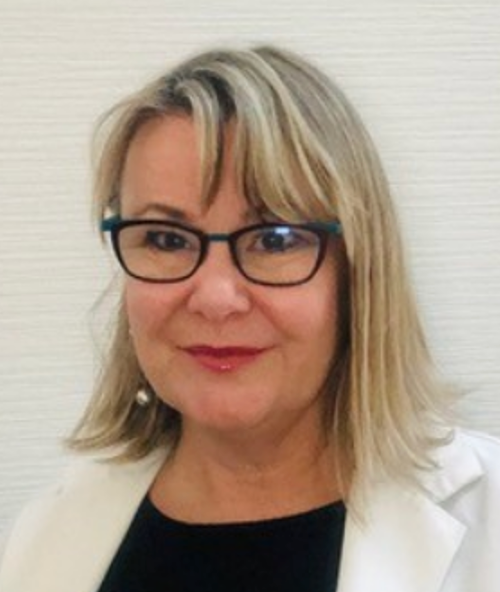
Dr. Jane Van Den Biggelaar isn’t scheduled for her locum in the RJH ED until August, but she wanted to get a jump start on electronic ordering as soon as she returned from a month of traveling this week.
“I’m booked for five morning shifts in a row so that I would be efficient,” says Dr. Van Den Biggelaar, whose regular part-time practice is in the Lower Mainland.
“I’m figuring it out, and it’s a bit time consuming,” she says, adding she has appreciated the at-the-elbow support available from Provider Education and Experience team members and IHealth medical staff champions.
Dr. Van Den Biggelaar completed her training over the past several months but says the hands-on learning with the live system and patients in the ED has been the greatest value to her.
“I find in the training environment it’s just too perfect – everything is done. And the little things that are important to us…you actually have to do it,” she says. “So, having someone sit with you and just go through the orders is the best way.”
Read the IHealth daily key messages
Celebrating National Indigenous Peoples Day with RJH staff

Today is National Indigenous Peoples Day, this first day of summer. Take a moment to pause in your day and celebrate the vast and rich cultures, traditions and contributions of Indigenous peoples across the country.
RJH staff, patients and visitors stopped by to visit with colleagues from Indigenous Health and Diversity, Equity and Inclusion in the PCC atrium.
Sekwan Wabasca, Manager, Cultural Safety and Humility (on right), and Sabrina Brandson, Communications Specialist, shared resources, answered questions and met with people interested in learning more about the First Nations and Métis communities in our region and beyond.
Spotlight Q&A

Name: Breanna White
Role: Health Information Management Training Lead
Currently Assisting: RJH Renal Department
From: Vancouver Island
EHR Benefit: The biggest benefit I see with EHR is it facilitates easy access to electronic health records for all clinical staff, ensuring streamlined and accurate documentation.
Tip: Don’t hesitate to reach out to team members for support if feeling anxious about the change.
Tourist activity you recommend to your support team members from out of town: Explore the scenic beaches and the outdoor activities that the Island offers. Canada Day is also coming up, downtown will be buzzing!
Bottom line: The activation process has been smooth, and I wish everyone ongoing success in utilizing the new system.
Support at the elbow, on the desktop and remote
Find support when and where you need it during Go-Live. If you need help or have a question, reach out 24/7 to support staff on your unit, use the “Band-Aid” tool at the top of your screen to get help, or call IHealth Central Support at 1-855-755-7001 or 28555.
Key Links
- Wednesday June 19, 2024
-

UVIC student nurses like reminders and safety measures in the new system
Carter MacDonald (left, above) and Molly Schneider are student nurses from UVIC working in Heart Health finishing their third-year clinical placement.
Island Health has 173 student nurses in clinical placements at RJH during the IHealth deployment.
“I like having everything in one place,” said Carter. “It’s nice that you’re not trying to find a paper chart. Everything you need is literally all there on the computer.”
“The online system helps prevent medication errors, by decreasing the risk of miscommunication. It’s also very sensitive, so if you scan a medication but it’s the wrong dose and the pill needs to be cut in half, it will tell you.’”
Molly also finds the reminders useful to reduce errors and, ultimately, improve patient safety. “I find there are some good prompts before you give medications and afterward such as, ‘Have you checked the lab values? Is it truly safe to give?’ And afterward you will be asked to report the outcome and response, ‘Was it effective? Why?’”
“I know other Health Authorities have been doing all online charting for a while so that’s proof that it does work and that it’s only going to become more efficient.”
Island Health’s Clinical Learning and Knowledge Services (CLKS) Student Practice team has been at RJH supporting students, faculty, educators, preceptors, and employed students during the CPOE Go-Live. Student Practice advocates for students and works with Island Health teams to ensure quality practice and education environments.
Confidence grows, learning continues as RJH Go-Live continues in Week 2
Royal Jubilee Hospital (RJH) is in Week 2 of launching Computerized Provider Order Entry (CPOE) after starting June 8, and many staff and physicians who were feeling anxious at the beginning are now feeling more comfortable after a few days on the new system.
“I’m very pleased at how well our launch is going,” says Candice Keddie, Executive Director at RJH. “It is a reflection of all the hard work and training that our teams completed in preparation for Go-Live.”
The overall feeling so far is that of “increasing confidence”, according to Associate Chief Medical Officer, Dr. Eric Shafonsky.
An incredible 1,800+ tickets equalling more than 72% of the total logged have been resolved so far. Medication and patient barcode scanning rates are rising with units 2S, 6N and CVU among the most proficient in scanning for patient identification, and units 5S, 2S, 4N and 1N showing the highest rates for scanning medication (as of June 18).
The ED overflow area has seen approximately 20 to 30 patients from the emergency department each day to help ease pressure.
Site and senior executive leaders would like to thank RJH staff for their patience and dedication, and the many individuals, teams and sites across the region for their support. Congratulations to everyone involved; these are results to be proud of!
Keddie says it’s been a long road, and knows that people are tired, but wants to reassure teams, “It’s still early days. Things will continue to get smoother as teams get used to the system and supports remain in place.”
“I think a bit of the initial energy and enthusiasm has waned a little,” she adds. “But we are through the worst part and it’s going to get better from here on in.”
Read the IHealth daily key messages

Barcode Medication Administration is an essential component of Positive Patient Identification and medication administration. The statistics show that more and more staff at RJH are using the barcode scanner, with usage fluctuating day to day.
Over the last few days, average rates across our site for scanning patient identification ranged between 66% and 76%, with some units as high as 89% – CVU, we’re looking at you!
Medication scanning usage is even higher averaging from 74-79%, with the highest rate in 5S at 91%! Keep it up!
Barcode scanning is best practice for supporting patient safety, as it augments Positive Patient Identification and is an important step in medication administration. This is a key component of the Closed Loop Medication System, injecting technology into every step, including those critical seconds before patients receive medications.
Go-Live Reflection: Day 12

“We can see what’s coming (on the lab cart laptop), and we can just let them know we’re going to that area if there’s more (specimen) collect on the same floor. At least we don’t need to go anywhere else, not as much running around. It’s pretty neat, it made the work easier.”
– Alyssa Cabbab, RJH Lab Assistant, collecting specimens on 4N with the new lab collection cart
Spotlight Q&A

Name: Dr. Christina Botros
Role: Physician support based in the ED
From: Emergency resident at Vancouver General Hospital
Previous activations: Vancouver General Hospital and St. Paul’s Hospital
Benefits of IHealth: I currently work at Royal Columbian Hospital in New West and it’s my first time working at a paper site in years and it’s brutal trying to find charts. I spend so much time locating charts. And then trying to read other people’s writing is such a pain. The electronic system is so much better for staff, physicians and patients.
Tip: Take the time upfront while you’re learning to optimize your system. Add items to your favourites and homepage and it will be a time saver in the long run.
Support at the elbow, on the desktop and remote
Find support when and where you need it during Go-Live. If you need help or have a question, reach out 24/7 to support staff on your unit, use the “Band-Aid” tool at the top of your screen to get help, or call IHealth Central Support at 1-855-755-7001 or 28555.
Key Links
- Monday June 17, 2024
-
VGH staff at RJH supporting CPOE Go-Live

Saturday, June 15, the EOC Crew was headed up by VGH Executive Director Gillian Kozinka (centre with green vest) as well as (from left) RJH Program Manager Alyssa Andres, James Bay UPCC Manager Jo-Anne Beeren Parsons, RJH Director, Mental Health and Substance Use Tasha McKelvey, and Cardiovascular Unit Manager Alison Koropatiniski.
On Monday and Tuesday last week, Bonnie Hannam was not at her typical workplace, which is at Victoria General Hospital Unit 4AB as a clinical nurse educator (CNE).
“I was at Royal Jubilee, in the Emergency Department,” says Bonnie from her office back at VGH.
Her motivation for helping out at RJH during the IHealth Go-Live was to ease the load on the clinical side by taking on some bedside care, while the nurses who had been freshly trained on CPOE got used to the advanced EHR side of their work.
I was thinking, “At least I can be hands-on with the patient, and they can help learn the system and then slowly I can also see how the system is working over there.”
The lessons Bonnie learned working alongside her RJH colleagues will come in handy when VGH goes live September 14. And Bonnie was just one of several VGH staff who raised their hands to support the RJH Go-Live. Those who came had the advantage of seeing both successes and issues to be flagged for resolution. Their time here was a preview of what to expect when it’s their turn to go live with CPOE.

Susan Butler (left) Manager of Perinatal Services/NICU at VGH gives ICU Manager Carrie Homuth a hand on Day 1.
Susan Butler worked with RJH colleagues in ICU, both for clinical cutover and actual Go-Live.
“People coming from other areas of Island Health brought irreplaceable knowledge that was here for us when we really needed it,” says RJH ICU Manager Carrie Homuth.
“Especially that first weekend with cutover and then going live, we couldn’t be at every bedside checking orders and making sure every order was inputted the right way,” Carrie adds. “So, we had to divide up the work and dive into charts and ensure that all the orders were up to date. It couldn’t have been done without people like Susan here who understand the business and our workflows.”
Carrie sees that peer support element as one of the essential ingredients for success Island Health has at its disposal looking ahead. “Staff here appreciated it, and so I know they will want to pay it forward and return that favour when it comes time for VGH to go live in the fall.”
Read the IHealth daily key messages
Cataract Clinic team leans on one another to ensure smooth IHealth rollout

RJH Cataract Clinic colleagues (l-r) Barb Vinnish, Michelle Cox and Kam Finch came together with their team to ensure the smoothest IHealth rollout possible.
There’s a lot of finger-pointing going on at the Cataract Clinic at RJH – as to who can be credited for the relatively smooth roll-out that started on June 8.
“It was easier than I thought it was going to be, and I’ve been hearing that from colleagues too,” says Michelle Cox, Registered Nurse, who works at the clinic doing surgical ophthalmology cases in the OR.
With cataract cases lasting an average of 10 minutes each, the clinic needed to ensure that patient charting would be efficient.
“It's all the hard pre-work that Barb, our charge nurse, did to get all the info in the preference cards,” says Cox. “We even have more details about cases in this system now, too.”
Barb Vinnish, the Clinical Nurse Leader, points to others – all the others on the team, in fact – for their EHR rollout success.
“The thing that is special about this place is that every single individual here is special – it’s the team,” she says. “We have good camaraderie; everyone works well together. We support each other, we have each other’s backs, we listen to each other when we’re frustrated, and I feel like that’s why we’re having this success. I’m very proud of the team, and how well they’re handling this and still putting the patients first as we’ve always done.”
When it comes to electronic orders, remember to ROAR!
Medical staff are reminded to keep this acronym in mind as they get used to entering orders electronically.
Review (existing orders)
Order (enter new orders)
And (refresh)
Review (orders again)
It’s a simple way to create muscle memory for accurate, up-to-date orders. Thank you, medical staff!
Behind the scenes at IHealth support

IHealth project analyst Ryan Basi.
When looking for help with the electronic health record during the RJH Go-Live, medical, clinical, allied health and clerical staff can press their Band-Aid button, pick up the phone, or look for a coloured t-shirt and help is at the elbow or on the way.
But what is going on behind the scenes to provide that timely support and resolve issues?
IHealth project analyst Ryan Basi spends his days making sure no issues, or “tickets”, fall through the cracks, so to speak.
“I'm going through all the tickets and making sure we're moving them along and addressing the highest priority issues," says Ryan. "Some tickets are straightforward, other ones are more complicated and might take more time or more steps to resolve. It's not just about closing tickets, it's about making sure the issue is actually resolved and doesn't cause an unforeseen issue somewhere else.”
Last Wednesday, Ryan noted, the percentage of closed tickets was at 55 per cent. Now the percentage closed is at 72 per cent.
“An issue either gets brought up with an on-site person, or it gets brought in through our call centres, then we log it, and it goes to our call takers and triagers to assign to a Tier 2 support group, or to dispatch someone on site to go take a look.”
Many of the tickets can be closed quickly, but some require decision-making at the clinical governance level, and those stay open until those decisions are made.
Currently with teams of on-site support available, a lot of questions are asked in person, compared to people phoning the Help Desk or opening the Band-Aid app on their workstation. The Band-Aid app will be available for the four-week period of active support. Once the stabilization and support period has ended, people will still be able to call the IM/IT Help Desk with any questions.
Spotlight Q&A

Name: Lasonya Cousin
Title: Oracle Cerner support
From: Georgia, United States
How it’s going? Today is my first day supporting this activation and my first time in Canada!
Area: 4 N and South in the PCC
IHealth benefit: Helps with medical errors. People get lost, legibility can be an issue. If it’s a computer, it’s tracked better.
Looking forward to on days off: Fisherman’s Wharf, Beacon Hill Park, and riding the harbour ferry/water taxi.
Tip: There’s always multiple ways to do something. You can pick and choose which options work best for you.
Support at the elbow, on the desktop and remote
Find support when and where you need it during Go-Live. If you need help or have a question, reach out 24/7 to support staff on your unit, use the “Band-Aid” tool at the top of your screen to get help, or call IHealth Central Support at 1-855-755-7001 or 28555.
Key Links
- Saturday June 15, 2024
-
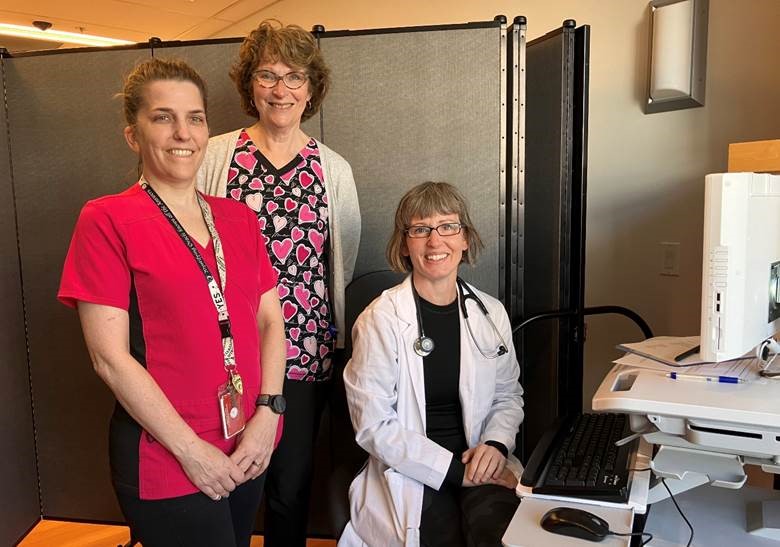
From left, RNs Julie Grant and Rose Dick, Dr. Melissa Duff at the RJH Overflow Clinic, beside the Food Court
Small space, big impact: overflow area helps relieve pressure on ED
It’s a small but mighty space and team running out of the former discharge lounge off the RJH main Patient Care Centre (PCC) entrance, helping to relieve pressure from the Emergency Department (ED) while staff adapt to the new system. From sutures, strep throat, UTIs, falls requiring x-rays – family physicians, nurses and admin staff are pulling a variety of patients from the ED.
Julie Grant, a Registered Nurse, has worked in the space since it opened Tuesday, June 11. “When we first opened, it was a lower volume day for the ED. But today there’s a higher ED volume so it feels like we’re benefiting more. Patients have a shorter wait time, and it benefits staff too. One of the nurses in Emerg said they have room for people to sit down in the ambulatory waiting room, which makes a difference to staff, so they have the ability to just breathe for a second.”
In the first 90 minutes of operation today, Grant said they saw 11 or 12 patients.
Dianne Walter, Clinical Nurse Lead in the ED, said they can feel the difference the overflow space team is making. “It’s great,” Walter said. “It’s helping immensely and making a huge difference. I think they saw 34 patients in total yesterday.”
Read the IHealth daily key messages
Scrubbing in together: visiting physicians team up with RJH staff to help master EHR
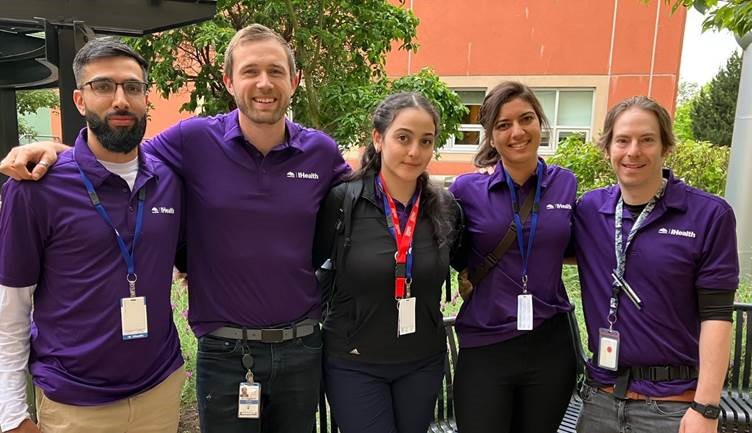
Visiting residents work as physician peer mentors during the RJH Go-Live
In the Operating Rooms of RJH, Dr. Arsh Sidhu – a resident physician in the Department of Orthopedics at UBC in Vancouver – is helping his colleagues adapt to electronic ordering and other new functions in the electronic health record. Dr. Sidhu is one of 32 resident physicians who have travelled from neighboring communities to assist medical staff at RJH during the current Go-Live.
“It was a huge change for surgeons,” Dr. Sidhu explained, “but they picked this up quickly – they’ve figured out that, one, it provides better patient care because it provides checks and balances… making sure that patients are getting consistent care across teams. And when [surgeons] figured out that this will actually save them time, that is when they started getting onboard – especially the ones that have been here multiple days through the week. The confidence is growing, you can see it.”
Physicians who were initially apprehensive about the new system are realizing just how personalized and customizable the EHR can be. Though the learning curve comes with challenges, the system is already yielding new benefits. “We started out adding 30 minutes to every case, to allow for the adjustment to CPOE, but we’re actually finishing ahead of time,” said Dr. Sidhu. “Morale throughout the week has increased significantly.”
Physicians like Dr. Sidhu are in a unique position to help physicians and care providers, bringing together their knowledge of both the Cerner system and the workflow of medicine in order to better assist staff during the adaptation period. “We’ve been using Cerner in Vancouver for three years now.”
Bringing together disciplines for quality, safety and practice improvements
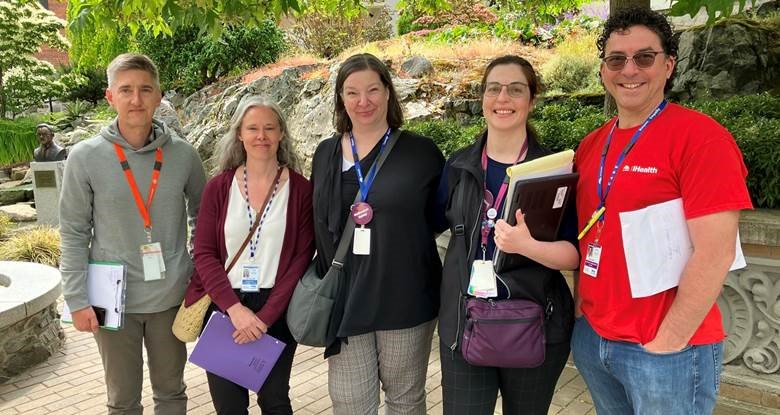
A few members of the Quality, Safety & Practice Hub: Michael McAuley (left) and Lori Gallins from Professional Practice; Samantha Chande and Emily Norman from Medication Safety; Richard Cox, a consultant with the IHealth project team.
Every day during Go-Live, an interdisciplinary team of patient safety leads, medication safety specialists, professional practice consultants, informatics specialists and quality improvement professionals meet for the Quality, Safety and Practice Hub. Together, this group is ensuring that best practices are being upheld through the IHealth Go-Live, supporting the care teams, and deploying teams to address issues as they arise.
At their meeting Friday morning, one suggestion that a member brought forward was finding places to recharge some workstations on wheels (WOWs) at night closer than “the end of the hall,” to encourage nurses to continue completing bar-coded medication administration. Another member was delighted that a nurse was getting comfortable enough with the new system to be curious about integrated plans of care, specifically the falls prevention care plan that was active for one patient.
“We looked at the appropriate phase that was initiated, we talked about the post-fall phase that is not appropriate until a patient falls, and then we walked through how to document and plan,” says Samantha Stockand, of Professional Practice.
“She said, "Oh, I remember that from the training, but can you tell me again.’ So, it was a really good moment for us.”
Nichole Pereira, Director, Patient Safety, is excited not only about collaborating across disciplines to find themes and trends to communicate back to care teams, but also how quickly the process is working.
“A highlight for me this week has been the efficiency of the process. It’s very cool to close the loop on an issue while it is still an active concern. And this is happening multiple times a day. We’re seeing resolution!”
Focus On: Pharmacy Informatics

Pharmacy Informatics team from left: Anders Foss, Dr. Amanda Johnson, Josie Randhawa, Shelly Spina and Annie McElwain
“We play a vital role in the medication journey by building the fundamental building blocks in the system. We ensure medications are properly configured so physicians can order them, pharmacists can verify them, and we can reliably dispense them to patients. Our team has a hand in nearly every aspect of this process. With the new electronic health record system, we're excited because it brings transparency that allows us to standardize and optimize patient care.”
~ Dr. Amanda Johnson, Coordinator - Pharmacy Informatics
Spotlight Q & A
Name: Annie Parry
Title: Provider Education and Experience (ProEx) informatics educator
Previous activations: RJH clinical documentation, St. Anthony’s Primary Care, Westshore Urgent Primary Care, North Quadra and James Bay Urgent Primary Care
Role: Generalist but focused on Radiology, Anesthesia, Emergency
What’s working well: Having physician peer mentors beside them working in their area, who speak their language and know their specialty is huge for them.
Looking forward to on days off: Hoping to celebrate our successes with my teammates with a beverage or two once this is done. I’m also looking forward to spending more time outside in the sun.
Hot Tip: Ask for help if you don’t know. Take the time to get the right answer and workflow so you don’t create bad habits that are harder to break.
Support at the elbow, on the desktop and remote
Find support when and where you need it during Go-Live. If you need help or have a question, reach out 24/7 to support staff on your unit, use the “Band-Aid” tool at the top of your screen to get help, or call IHealth Central Support at 1-855-755-7001 or 28555.
Key Links
- Friday June 14, 2024
-

RJH marks one week of CPOE
It has been one week since the launch of computerized provider order entry (CPOE) at RJH. Across the hospital, people are used to the presence of red, green and purple shirts of support teams, and signage is everywhere, notifying visitors and staff of the active ‘Major System Upgrade’.
When asked to reflect on their experiences so far, staff have spoken about the growing optimism surrounding the new system.
"It's really exciting. There haven’t been any changes for many years, and I am happy to learn something new," says Sachiko Hikawa, an RN in Hemodialysis.
Clarene Ho, RJH Pharmacy Site Coordinator, praised her team's hard work. “We’ve been anticipating the advanced electronic health record system for a long time and glad that we’re here now. Our team worked hard in preparation. There were hurdles with such a huge change, but Pharmacy staff did a fantastic job adapting and rolling with the changes.”
At the IHealth Command Centre in PCC 150, project staff are encouraged that they are consistently attaining a “resolved” rate of 70 per cent of service tickets. Those tracking use of devices are pleased that ordering providers are using the new Controlled Prescription Printers, with 38 prescriptions securely printed from these devices at RJH this week. Site-wide, people are putting down their pens, and using the EHR to create and to carry out orders.
Supporting this work are a number of key groups, including a patient quality team that monitors patient and medical safety, an emergency operations centre that manages issues and risks, shift handover meetings, and governance meetings that make decisions about proposed changes to EHR workflows and functions.
Read the IHealth daily key messages

Job aids make patient transfers easier
As patients move through the care system – between facilities that could be fully or partially active in the EHR, or paper-based – there is plenty of opportunity for information to fall through the cracks. Unless, providers and care teams pave the way for the information to move. This is why a large emphasis is being placed on patient transfers and information management.
For transfers between RJH and other sites (aside from VGH/GRH), two laminated handouts have been prepared and distributed to nursing stations at all inpatient units, ED and ICU. One is created for providers, which details their steps, and the other is for MRNs, NUAs and CNLs.
Lesley Seminoff, an NUA on 4South, is impressed with the clarity of the new tools. "This is beautiful, it is every step that we need," she says.
Based on the feedback and success of this initial tool, Medication Safety is developing a similar tool to support unit transfer processes.
"You don't have to know everything. Use the tools," says Andrea Lapaire, RN and Medication Safety Consultant.
Her colleague, Samantha Chande, agrees: "It's a new way of doing a process that we've always been doing."
Staff ‘WOWed’ by new WOWs

Jessy March scanning a barcode at the slimmer version of the WoW
“Everyone loves the new Workstations on Wheels (WOWs),” said Sandra Bast, IHealth Project Analyst.
145 new slim format WOWs have been delivered to RJH for Go-Live. They have an easy "Tap n Go" log-in and maneuverability.
A few different types of WOWs are available: the physician workstations have a Dragon Microphone for dictation, while the nurses’ workstations have a barcode scanner. There are also a number of hybrid WOWs with both features, as well as stations for students.
“Overall, the transition has been smooth, and the immediacy of online ordering in real-time will help with medication safety, enabling us to expedite patient care so we are providing the right care at the right time,” said Jessy March, RN in the Emergency Department.
Go-Live Reflection: Day 7
I'm a new employee - I've come from Fraser Health, and I've only been here a month. The fact is, it's lovely being able to have access. Everything else was paper before, so it's lovely have access to see the full picture of the patient.
- Lesley Seminoff, Nursing Unit Assistant, 4South
Support at the elbow, on the desktop and remote
Find support when and where you need it during Go-Live. If you need help or have a question, reach out 24/7 to support staff on your unit, use the “Band-Aid” tool at the top of your screen to get help, or call IHealth Central Support at 1-855-755-7001 or 28555.
Key Links
- Thursday June 13, 2024
-

Super-user physicians are helping peers adapt the EHR to their needs
Dr. Megan Singh, a resident physician in Emergency Medicine from Vancouver General Hospital, has been helping Emergency Room staff personalize and adapt to the new capabilities in the Electronic Health Record (EHR) over the past six days.
There are 32 resident physicians, from numerous regions, using their familiarity with EHR to support staff and medical staff through the transition.
“I feel like my role is helping Emergency Room physicians make the system as optimized as possible to their personal preference,” Megan explained.
“One ER physician asked me urgently for help because she thought she made a mistake and jumped the line, when a patient was picked up within minutes of entering the CT order. That’s truly how efficient the new system is when they instantaneously get the requisition. Previously, this would have taken about five steps to walk over, write the chart, fax it, then radiology would have to receive it and protocol it.”
Staff in Emergency have felt supported by Megan.
“She’s been phenomenal,” said Amanda Paquette, an RN and Clinical Nurse Educator in the ED, about the help they've received from Megan.
“I’ve seen a lot of improvement from Saturday to today,” shared Megan. “We’ve had some people excited about some of the specific personalization they’ve got. They’re excited about how efficient it’s getting in certain steps. As things get more efficient, it will mean we have more time for patient care.”
Read the IHealth daily key messages
Nanaimo Nurse Educators share lessons from eight years with the EHR

Nanaimo Clinical Nurse Educators, Tammy Joseph and Janet Vennard, have had a lot of experience with the Electronic Health Record since it went live at their hospital eight years ago. Now they are taking the many lessons they’ve learned to RJH, where they are “paying it forward” to clinical staff.
“We have an understanding of how it functions in Nanaimo and can see where people might be struggling here,” says Tammy. “If we can do the proper workflows now at the beginning, then it will help support practice, safer patient care, and easier transitions of care.”
Among those assisted at RJH is Linda Beth Juchli, an RN in the ICU, who described having the extra support as being “Absolutely fabulous! When you have a person there with you, who really understands this, it makes the transition easier. This change has been challenging, but we can feel the optimism ahead.”
Janet says “Our role as CNEs is to support practice and get across the “why” you’re doing something. We’re messaging to staff that you do not have a computer dictate your care. You are caring for the patient in the bed. This is a tool.”
Tammy adds, “People still need to talk to each other. Yes, we’re automated but you still have to talk to your colleagues – you still have to talk to providers.”
“We are not in robot land,” says Janet. “The EHR is not taking the people out of the hospital”.
SWOT brings cross-team focus for priority fixes

In the first 48 hours of the Go-Live, frontline staff, clinical operations and IHealth teams started to see departments with multiple service requests on a particular issue or challenge – and the potential effect this could have on adoption and use of the new system.
Small groups – known as SWOTs – were quickly convened, with representatives from the department or unit with clinical operations, IHealth project, clinical/medical informatics and other supports to identify the highest priority issues and jointly tackle what could be done to overcome each challenge.
There are SWOTs for Critical Care, Emergency Department (ED), Medical Imaging, Heart Health, Renal and Transfusion Medicine. Representatives from Quality and Professional Practice, Medication Safety, Laboratory and other areas join, as needed.
The teams meet to focus on critical and high priority issues, especially those with multiple similar tickets, affecting the most users. Meetings are quick and to the point, laying out what governance decision-making steps need to happen to effect the change.
“It’s been amazing,” says Amanda Paquette, RN and Clinical Nurse Educator in the ED. “A policy change and approval that would normally take, literally, years, we got done in a day, and ED staff were working with it the next morning.”
This policy change significantly improves the electronic process and workflow for triage nurses, which was a particular pressure point switching from the paper process to the full EHR.
More streams or clinical areas may be added, as required. Newly developed dashboards will help leaders independently check the status of issues being addressed, clarify questions and stay coordinated with one another.
Spotlight Q&A
Name: Jeannette Bantugan
Role: Senior Consultant
From: Fairfield, California
Based in: RJH Renal
Tourist activity looking forward to: I’ve booked a spa appointment at HAVN Saunas.
IHealth benefit: Patient safety, with all the double checks, and all the alerts in place.
Pro Tip: It’s going to seem like a lot of work right now. But once everyone gets the hang of it, it will help a lot with patient safety.
Go-Live Reflection:
Day 6“I was pleasantly surprised that printing a duplicate prescription worked perfectly the first time I tried to print to the dedicated printer on the unit...definitely very convenient!”
-- Dr. Ramm Hering, Lead, Primary Care Addiction Medicine
Support at the elbow, on the desktop and remote
Find support when and where you need it during Go-Live. If you need help or have a question, reach out 24/7 to support staff on your unit, use the “Band-Aid” tool at the top of your screen to get help, or call IHealth Central Support at 1-855-755-7001 or 28555.
Key Links
- Wednesday June 12, 2024
-

A safer patient journey starts at Registration & Admitting
For the clerks at Registration, the implementation of the electronic health record (EHR) doesn’t really change their process – but in one way, the transformative IHealth approach starts with them, at the front door.
“We are so often that first person in the patient’s journey. Our process doesn’t change, we’re still validating and confirming all patient demographics and updating in real time,” says Sydney Razmus, Manager of Registration and Health Records. “We want to make sure we put an ID band on the right person, knowing that we’ve done our part, so the rest of the hospital visit can flow smoothly. We’re all working in this together.”
Lauren McNeil accompanied her husband Bryan to RJH on June 11 for his outpatient surgery. She was aware of the change, since her sister is a nurse at RJH. “It’s good. I think it’s probably about time,” she says. “I’ve noticed lots of other hospitals in the U.S. that are electronic. It’s even safer now for patients.”
Bryan is relieved to know that there will be more safety precautions in place. “It makes sense. Now I know for sure I’ll be given the right medication rather than someone else’s.”
Read the IHealth daily key messages
BPMH gets a digital upgrade
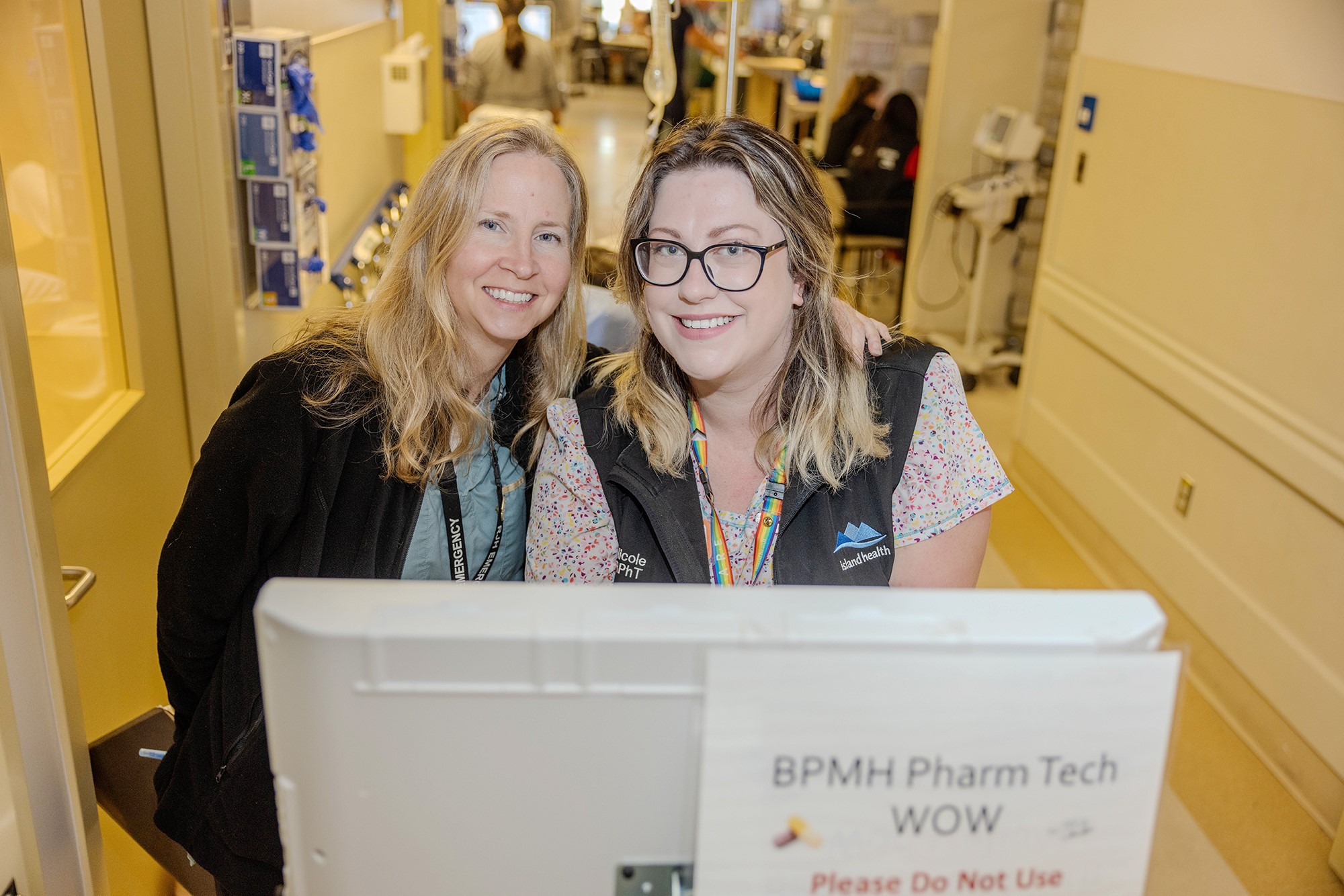
BPMH Pharmacy Technicians Rose Barley and Nicole Marceau
Island Health's advanced EHR system allows comprehensive Best Possible Medication History (BPMH) to be easily maintained and updated as patients move through the healthcare system.
Dr. Celia Culley, RJH Clinical Pharmacy Coordinator, highlighted the importance of accurate medication documentation. “When patients are admitted, accurately documenting their home medications is critical,” she said. “Our clinical pharmacy technicians interview patients at their bedside and electronically document all home medications. This allows physicians to reconcile those medications with new orders. The BPMH process helps identify possible medication reasons for admission. It also optimizes continuity of care, providing reassurance to patients that their home medications are being addressed on admission.”
Previously, the BPMH process involved manual and digital components, requiring pharmacy staff to piece together details from different sources.
“As patients get admitted and discharged, their current medication details will carry over, reducing potential gaps,” said Dr. Sean Spina, Regional Clinical Pharmacy Manager.
Within the first two days of Go-Live, the pharmacy team achieved a 100% rate for BPMH completion within four hours of admission for admitted patients at RJH, a stellar collective effort by staff and an early demonstration of how this change can benefit patient care.
Clarene Ho, RJH Pharmacy Site Coordinator, praised her team’s hard work. “We’ve been anticipating the advanced electronic health record system for a long time and glad that we’re here now. Our team worked hard in preparation. There were hurdles with such a huge change, but pharmacy staff did a fantastic job adapting and rolling with the changes.”
I Do...welcome the new electronic health record system!
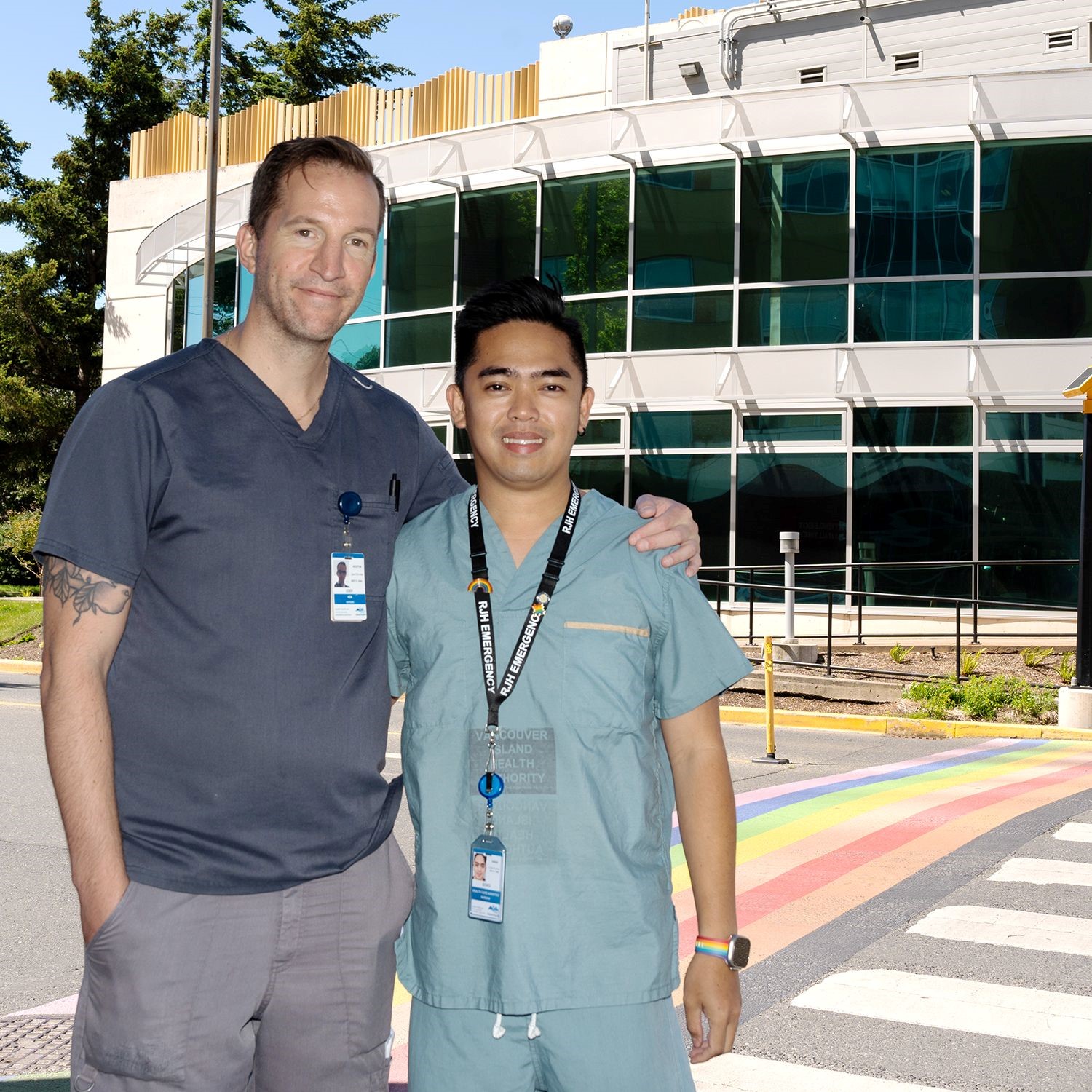
Cody Birchard (left) and Ecko Umbao
Just in time to celebrate Pride month, Ecko Umbao and Cody Birchard, a couple working at RJH, are doubly excited. Not only are they getting married this month, but they're also navigating the new EHR system together.
“As someone who's pretty tech-savvy, learning technologies isn't too tough for me,” said Ecko, who currently works as a healthcare assistant at the Emergency Department. “I'm excited to learn innovative ways to chart patient records and communicate with other healthcare team members with just a click.”
Cody, also a healthcare assistant at RJH, added, “Going digital is convenient and environmentally friendly, so I'm all for it. While adjustments take some getting used to, it’ll become second nature eventually.”
The couple, who met working at the hospital, are looking forward to the long-term benefits of the new system together.
“We're a team, through everything life throws our way, including this new system,” said Ecko.
Spotlight Q&A
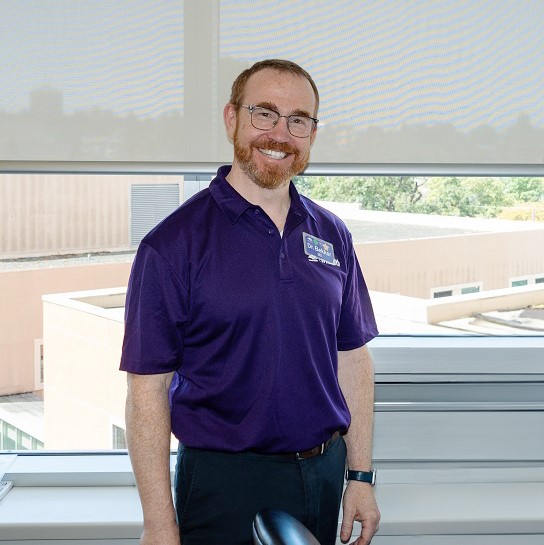
Name: Dr. Ian Bekker
Role: Long-Term Care/geriatric physician; IHealth Lead for Long Term Care; IHealth Physician Peer Mentor
Based: Victoria and Saanich Peninsula
Island Health employee for: 13 years
How he got connected with IHealth: Background in engineering and an interest in technology that advances medical care. First connected to project in 2012 and was quickly handed the Island-wide primary care provider informatics meetings.
Previous activations: NRGH, CDH, Vancouver General, RJH, and VGH
The experience: “As we round, Purple Shirts need to be responsive but also a little intrusive into physician activities to help them find efficiencies they didn’t know were available. My approach is to sit in the charting room and watch a few of the physician screens at the same time. You can see when there are long pauses, frowns or rapid searching indicating the physician needs help. This is where I step in to help or offer hot tips.”
Being a Peer Mentor: “If a physician is frustrated with aspects of the change, we can certainly empathize. Change is hard, and physicians are being asked to do more things and/or do things differently. However, we balance that with moving them towards acceptance by reminding them of the personal and patient benefits of practice change.”
What is this experience like: “I’ve been working shoulder to shoulder with physicians and pharmacists. A lot of it is standing behind someone to guide them through processes and teach them shortcuts, such as how to get data from the chart into the notes really fast using auto text.”
Bottom line: “The training has been good and people’s comfort level is gaining fast. I think it’s not going to take long at all for this practice to be come routine – a lot of it is muscle memory. It’s really great to see our colleagues become faster and better at this practice, which ultimately is resulting in better patient care. This is what keeps us coming back to volunteer at Go-Lives over and over.”
Go-Live reflection: Day 5
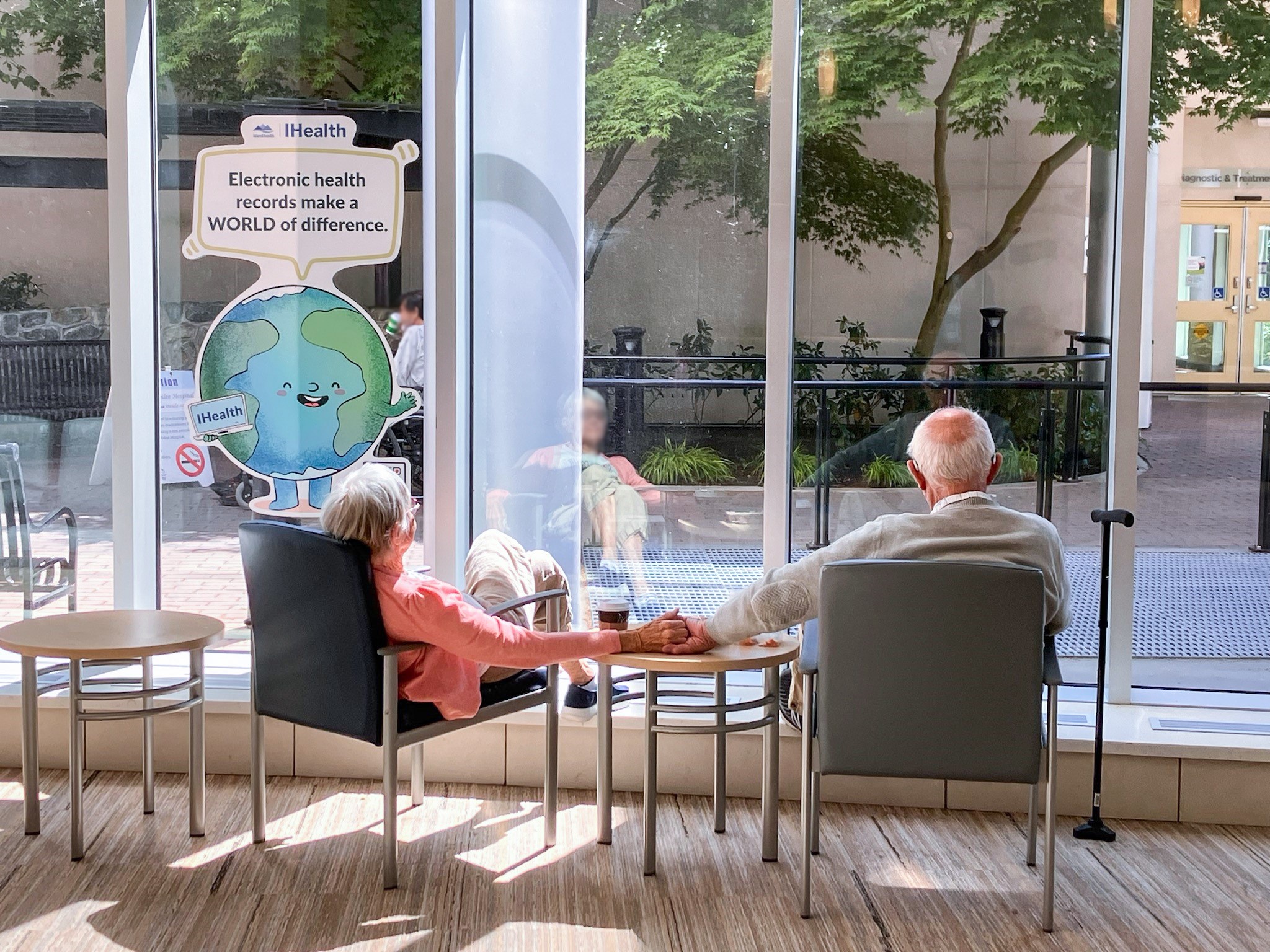
Support at the elbow, on the desktop and remote
Find support when and where you need it during Go-Live. If you need help or have a question, reach out 24/7 to support staff on your unit, use the “Band-Aid” tool at the top of your screen to get help, or call IHealth Central Support at 1-855-755-7001 or 28555.
Key Links
- IHealth Intranet
- Interfacility Transfers
- Communicating about IHealth with Patients, Clients and Families
- Orders Management Intranet page
- What’s Changing – By Roles
- Tuesday June 11, 2024
-

Cathy Edwards, ED Overflow triage nurse; Dr. Paul Sawchuk at a Workstation on Wheels (WOW) in the ED Overflow Clinic
ED overflow clinic supports RJH ED during CPOE Go-Live
“It’s 12:45 pm and we’ve already sent between 15 and 18 people to the ED overflow clinic.”
Cathy Edwards is refering to the extension of the Royal Jubilee Hospital emergency department created to support the RJH ED during transition to CPOE. While she is normally manager of the Westshore Urgent and Primary Care Centre (WUPCC), Edwards has been assessing patients who present at the ED to determine if their conditions are suitable for the overflow clinic.
“ED staff seem grateful for the support we are providing – I think they are noticing a big difference,” she said. “Wait times are going down in the ambulatory area, and patients have been so thankful to be getting care fairly quickly.”
Dr. Paul Sawchuk is medical co-lead for South Island UPCCs. He’s joined Edwards in lending support to RJH ED staff by working as a physician in the overflow clinic.
“ED staff have been super supportive in helping us determine how to get the work done through the course of the day and also appreciative that we can take some lower acuity patients off of their list,” he said. “We’ve been able to provide good service to patients and there is a positive sense of camaraderie with staff.”
Between 25 and 32 patients have been seen each day in the ED overflow clinic.
Correction from June 10 issue:
We have a correction to the June 10 story, “Long-time nurse gets VIP tech support from daughter on ambulatory Go-Live”: “Sue Brasset has been nursing for 58 years, 39 of those with Island Health.”
Read the IHealth daily key messages
Rainbow rounds enhance IHealth support

From left, Vice President of Medicine, Quality, Research & Chief Medical Officer, Dr. Ben Williams; Junior Project Analyst Ben Villares; Senior Specialist Clinical Informatics Amy (AJ) Hunter; and Client Delivery Leader Ally Scott
In a vibrant display of teamwork and expertise, the "Rainbow Rounds" initiative at RJH is making supportive waves during the implementation of IHealth. These colourful teams of specialists circulate throughout the hospital during Go-Live, ensuring that clinical and medical staff receive the necessary support and guidance.
"Recognizing that we all have different skills, we do our best to be effective knowing that we're all one resource for this implementation group to support our staff," says Dr. Eric Shafonsky, Associate Chief Medical Information Officer. This collaborative approach is visually represented by the shirts worn by different support specialists, each symbolizing their unique role and expertise.
Green shirts indicate Clinical Supports, many of whom come from nursing and allied health backgrounds and include team members with implementation experience from Oracle Health/Cerner. Red shirts are worn by Provider Education and Experience (ProEX) and Clinical Informaticists, focusing on learning, system and workflow optimization and adoption. Blue shirts are worn by people with a background in IM/IT, devices and other project specialties, who often tackle aspects related to the interface between the hardware and the people who use it. Purple shirts are physician peer mentors, many of whom have deep experience working in the EHR, providing valuable peer-to-peer guidance and support. Behind these colours are a host of other people providing additional support through clinical and project operations, in-person and remotely.
Dr. Shafonsky highlights the importance of this diverse team, stating, "At times, one individual colour or group will have that special relationship or technical skill to respond to an emerging issue." This tailored support is crucial as the hospital navigates the complexities of moving from paper to digital records. It also promotes interaction, coordination and sharing of experience between the various support teams.
Renal patient shows understanding while Go-Live happens around him
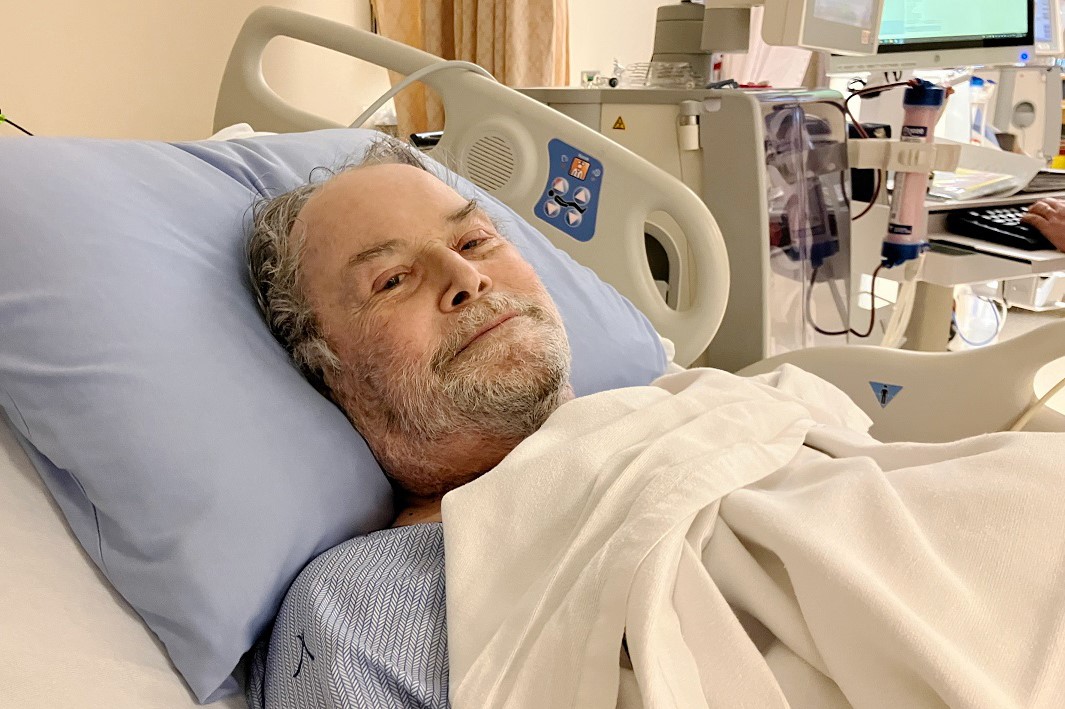
Renal inpatient William Phillips
Unlike many units at RJH who have been live with clinical documentation for over two years, the Renal inpatient department went from an entirely paper-based process to 100% electronic.
Along with that change has come many extra bodies on the unit, in the form of support. And with that support comes a level of noise that regular patients are not used to.
Janice Rotinsky, Manager, Renal Services says both inpatients and outpatients are noticing the increased activity and with it, a little more noise than usual. Rotinsky says that Renal staff continue to acknowledge the change and thank patients for their patience as they learn the new system.
Patient William Phillips was thoughtful when asked about the change and the noise level on the unit.
"It's not unreasonable that people will be focused on a new system, and as a result they need to have a lot more dialogue," says Phillips, "So it's a little noisy, I think that's true. Does it interfere with me? No."
"I empathize with everybody because I know that new technology is always difficult, especially combined with a difficult job to begin with,” he adds. “I think that everybody is doing well, and we can expect them to learn it quickly."
Spotlight Q&A

Name: Jade Lytwynuk
Role: Health Information Management Co-op student
Previous activations: IHealth Uplift at NRGH in May
Go-Live activities: On-site support, writing tickets
Why IHealth? I applied for my co-op with IHealth because I thought working Go-Live would be a good experience knowing I could help impact patient care and learn at the same time.
Go-Live learnings: I’ve worked many days consecutively for 12 hours at a time, but I find it rewarding knowing that it’s helping improve patient care and safety. And this has helped me discover where I want to take my career.
How to report a quality or safety concern
To report a quality or safety concern:
Go to the Go-Live Command Centre in PCC S150, or
Report it through the Patient Safety and Learning System (PSLS)
Support at the elbow, on the desktop and remote
Find support when and where you need it during Go-Live. If you need help or have a question, reach out 24/7 to support staff on your unit, use the “Band-Aid” tool at the top of your screen to get help, or call IHealth Central Support at 1-855-755-7001 or 28555.
Key Links
- Monday June 10, 2024
-

From left, Rose Barley, Nicole Marceau, Kelsey Perra, Dr. Celia Culley, and Dr. Sean Spina celebrate the BPMH milestone.
Admission BPMH rates hit 100% on first weekend of CPOE
A huge shout-out to RJH Clinical Pharmacy BPMH Technicians and all clinical staff and providers for achieving 100% Best Possible Medication History (BPMH) completion rates within four hours of admission while on shift this weekend! The overall average for the site during the weekend was 94%.
The excellent BPMH completion rate contributed to much-improved rates of medication reconciliation* on Sunday, June 9:
- 78% at admission
- 58% at discharge
This is a marked improvement already within the first three days.
Well done RJH Clinical Pharmacy Technicians, staff and providers!
*Medication Reconciliation is a three-step process where the interprofessional team works in partnership with patient and family to generate a best possible medication history, identifies and resolves medication discrepancies at admission, transfer and discharge, and communicates/makes available a complete and accurate list of medications to the patient and next care team.
Read the IHealth daily key messages
RJH staff raise the bar in use of new technology

Nurses Mackenzie Rampton (left) and Andrea Sinclair, with barcode scanners at the ready
It’s Day 3 of Go-Live and already staff are starting to take to the new tools, including the barcode scanner. The number of staff and medical staff using the new scanners to scan medication and patient wristbands is trending up.
“It’s been going pretty well. We’re going through the normal hiccups, but I am really enjoying the electronic switchover,” says Licensed Practical Nurse Andrea Sinclair, who previously worked at Ottawa Hospital, where they have been all-electronic since 2019.
“The new scanners can save a bit of time. As you’re scanning, it’s logging when medication is given, it’s just one click. Without the scanner we would have to physically, individually sign or document tasks.”
Registered Nurse Mackenzie Rampton started on the new system today. She highlights patient safety as one of the big benefits of bedside barcode scanning. “You can go in and see when the medication was scanned. It’s just another warning, another flag,” says Mackenzie, “It’s like having a second set of eyes with you all the time.”
Andrea and Mackenzie both work on 4 SW, where barcode scanning usage rates are among the highest at RJH, along with 3 SE and 5 SW. Both their stories highlight how important barcode scanning is in supporting patient safety as it augments positive patient identification and the 10 rights of medication administration, leading to a decrease in medication errors. Barcode scanning is an important step in medication administration and also a component of the Closed Loop Medication System (CLMS). For more information on medication administration visit the Medication Administration page.
Through this Go-Live, staff have also discovered that some of the barcodes required adjustment to ensure they are properly linked to the medications. This is currently being addressed.
Dawn Ball, a senior consultant with Oracle Cerner, has been supporting 4 SW. “The patient doesn’t have to worry about being misidentified. Every patient has a band with their identification, for the patient’s best care,” she says.
Long-time nurse gets VIP tech support from daughter on ambulatory Go-Live

RN Sue Brasset (left) gets help from daughter and Director of Clinical Informatics Heather Rocheleau
Sue Brasset, 80, a registered nurse for 39 years who works in eye surgery, was feeling anxious about using the new CPOE system today. But she felt supported by the team, as well as by her daughter Heather Rocheleau, who is Director of Clinical Informatics with the IHealth project.
“I am so exhausted. I know it will get better when we get into the flow of things, and it will be more proficient in the long run for patients,” said Sue.
Heather is clearly proud of her mom.
“My mom worked her first shift today, so I popped in to support her. I can understand people are feeling anxious when they are already stressed and understaffed.”
Emergency Department appreciates support with triage

Jo-Anna Wilson, Interim Manager at the Emergency Department of RJH
Emergency departments can be hectic at the best of times – add in a Go-Live activation and the intensity levels can ramp up even more.
“There was a lot of anxiety because it is the Emergency Department. It’s very complex, it’s very busy and there’s very rapid turnover,” says Jo-Anna Wilson, Interim Manager of the RJH ED.
But the help on hand has been superb, she adds. “As soon as we’ve raised any issues, the response from the activation team has been immediate,” notes Wilson. “And if they didn’t have the answers, they worked on them until solutions were found.”
For example, triage was “a little bumpy” during the first night after Go-Live as the ED team adjusted to the new system. “Our team connected with the CTTs (Clinical Transformation Team members) on Sunday morning, who now have put somebody at triage to support the team through the changes. And today we’ve got other informaticists on the ground who are helping our triage nurses set up their screens, so they don’t have to hunt and seek what they’re looking for.”
Wilson acknowledges other challenges will arise, but she’s confident in the process and the people behind this massive change.
“Overall, this has been a really good rollout. I know there are more bumps to come, but we’re confident that the team will support us in those shifts,” she says. “This emergency crew, despite the fact that we’re so short-staffed, are pushing through.”
“What an amazing team, and what a high level of professionalism I’ve seen from all of them.”
Spotlight Q&A

Susan Sieveking
Name: Susan Sieveking
Role: Clinical Strategist
Based in: Surgery, Anesthesia, Heart Health
From: Phoenix, Arizona
Previous activation: Lions Gate Hospital, North Vancouver
Tip: Go back to your core nursing. In technology, it’s people, process and technology, but we have to just go back to the people.
Tourist activity looking forward to: Afternoon tea at the Empress Hotel
Bottom line: If you’re questioning something, do what you would normally do as a nurse.
Support at the elbow, on the desktop and remote
Find support when and where you need it during Go-Live. If you need help or have a question, reach out 24/7 to support staff on your unit, use the “Band-Aid” tool at the top of your screen to get help, or call IHealth Central Support at 1-855-755-7001 or 28555.
Key Links
- Sunday June 9, 2024
-

The Pharmacy team takes a minute during the first day of Go-Live to gather for a photo. "Our process has undergone a big change,” said David Forbes, Director of Pharmacy Operations. “Previously, it involved multiple steps like scanning physician orders, transcribing them and manually entering details – a laborious process. Now, with physicians directly entering orders electronically, we've eliminated risks of illegibility, incompleteness and ambiguity. Orders now seamlessly flow into our system for pharmacists to verify. It's a significantly faster and safer workflow for us and the patients we serve.”
IHealth moves mountains…of paper in Health Records

“I have dreamed of this day,” says Bindy Bains, Executive Director for Health Information Management. “We’re drowning in paper; we’ve been worrying about space for years.”
One patient chart for an average four-day hospital visit can contain 150 pages. Now, with the electronic health record, the chart will be reduced to just a handful of pages.
With approximately 600,000 charts stored on-site at Royal Jubilee Hospital, and another 200,000 in bankers’ boxes in off-site storage, there is no physical space to keep paper charts anymore.
“One of the most important benefits now with electronic clinical documentation is that patient information is immediately accessible,” says Bains. “Whereas previously, it may take a few hours or even a few days for us to make the chart accessible to the care team.”
On top of space and access, this change will also help decrease staff injuries.
“My entire career has been managing a paper world and this changes the face of record management. It’s pretty incredible,” says Bains.
Read the IHealth daily key messages
Watch for treats rounding to units

The IHealth team and partners are bringing treats around units to thank staff and offer encouragement.
Dr. Sara Al-Adawi (left) gets a sweet treat in the ICU from Andrea Deschenes, Manager of Device Logistics and Acquisitions.
Q&A with a Cerner Adoption Coach
Name: Quincy Gardner (pictured below, at left)
Role: Oracle Cerner Adoption Coach, Clinical Support team
Based in: RJH E.D.
From: Mississippi, United States
Previous activations: Vancouver General Hospital, BC Children’s and Women’s Hospitals.
IHealth benefit: “The biggest benefit to me is that clinicians can see what’s going on with each patient encounter in real time.”
Tip: “Trust your co-workers. Every team has someone who over-prepares to make sure there’s nothing they don’t know. Know who those people are and rely on them.”
Tourist activity looking forward to: Whale watching.
Bottom line: “It may seem time consuming at first, but once you learn it, it reduces your time in front of a computer and gives you more time with the patient.”
You will recognize members of the Clinical Support team by their green shirts.
More reflections on Go-Live Day 2
“We did it! Survived the first day of CPOE! As your basic dinosaur and not very canny with new computer stuff, I think it was a resounding success…I feel proud of the whole institution and health authority. A day to remember in our careers!”
--Dr. Jean Maskey, Hospitalist Physician
“I'm slower right now because I'm trying to do this properly to set myself up for success in the future, like set up my favourites, but I know that eventually this will be faster and I’m going to like it.”
--Dr. Milvi Tiislar, Hospitalist Physician
Support at-the-elbow, on the desktop and remote
Key Links
- Saturday June 8, 2024
-
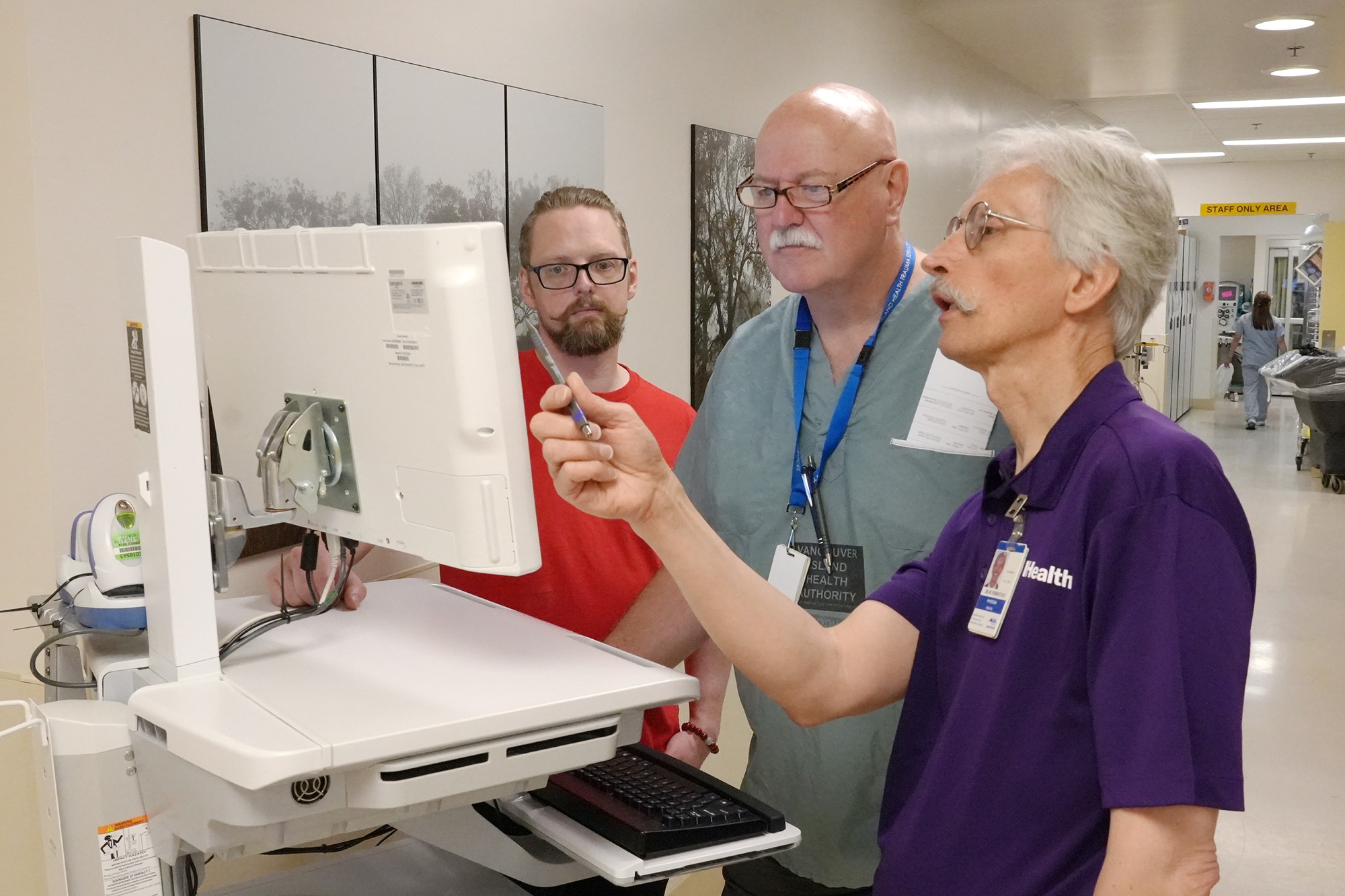
ICU Goes Live: Dr. Willie Pewarchuk, IHealth Physician Lead for CPOE/Orders Management (right) assists Dr. Alasdair Polson, Respirologist (centre) with his first electronic order, the transfer of a patient to another unit. Philippe Parenteau, Clinical Informatics Specialist with ProEX (left), was also there to support physicians. (See story below.)
RJH is live – Thank you, everyone!
Congratulations to RJH staff and medical staff – Royal Jubilee Hospital is now live with the advanced electronic health record system! After spending all night working through clinical cutover – transferring patient information from paper to the electronic health record (EHR) – units across the site started using computerized provider order entry (CPOE) this morning.
Clinical teams required additional time to verify accurate conversion of paper orders to the computerized system, with Go-Live taking place at 8 a.m. With a short Go-Live announcement overhead and a Citrix “splash page” message, staff on site made a change that will bring significant benefits to the delivery of safe, consistent quality care for patients at RJH.
ICU goes live with electronic clinical documentation and ordering
For staff in the Intensive Care Unit (ICU) at RJH, the last few months included preparation and training for not only electronic ordering, but also electronic clinical documentation, which other units in the hospital started using in September 2021.
ICU Manager Carrie Homuth took a few minutes to reflect on today’s Go-Live.
“Everything is coming together -- we’ve brought in lots of additional staff to ensure everything is as it should be,” she said.
“From a nursing perspective, our unit is very calm, allowing our staff time to learn and work through anything they are not understanding. We’ve been able to get everyone’s feet wet little by little to gradually learn all the new skills.”
Homuth is looking forward to learning more about how to use the electronic health record to plan future patient care. She acknowledges that some processes will evolve, and staff must respond to that change.
The ICU at RJH is the first ICU in Island Health to adopt full functionality of the electronic health record.
First orders of a new day
The first orders entered electronically at RJH were lab tests entered by Cardiologist Dr. Olivier Desplantie and Nurse Tara Frigon. Here’s what each of them had to say about Go-Live Day 1.
More reflections on Go-Live Day 1
“It’s going to take everyone going through their rotation to get familiar with the new system – we all need to use it for a few shifts and then it should be smooth sailing. It’s the first day and it’s only been a few hours, but we can be optimistic.”
--Lee Jenstad, CNL, Heart Health
"We must be flexible and listen when staff ask for help or tell us what they need. They are the ones on the frontline doing the amazing work and caring for patients. We are here to support them.”
--Lisa Young, Director, Infection Prevention and Control
Support at-the-elbow, on the desktop and remote
Find support when and where you need it during Go-Live. If you need help or have a question, reach out 24/7 to support staff on your unit, use the “Band-Aid” tool at the top of your screen, or call IHealth Central Support at 1-855-755-7001 or 28555.
Key Links
- Friday June 7, 2024
-
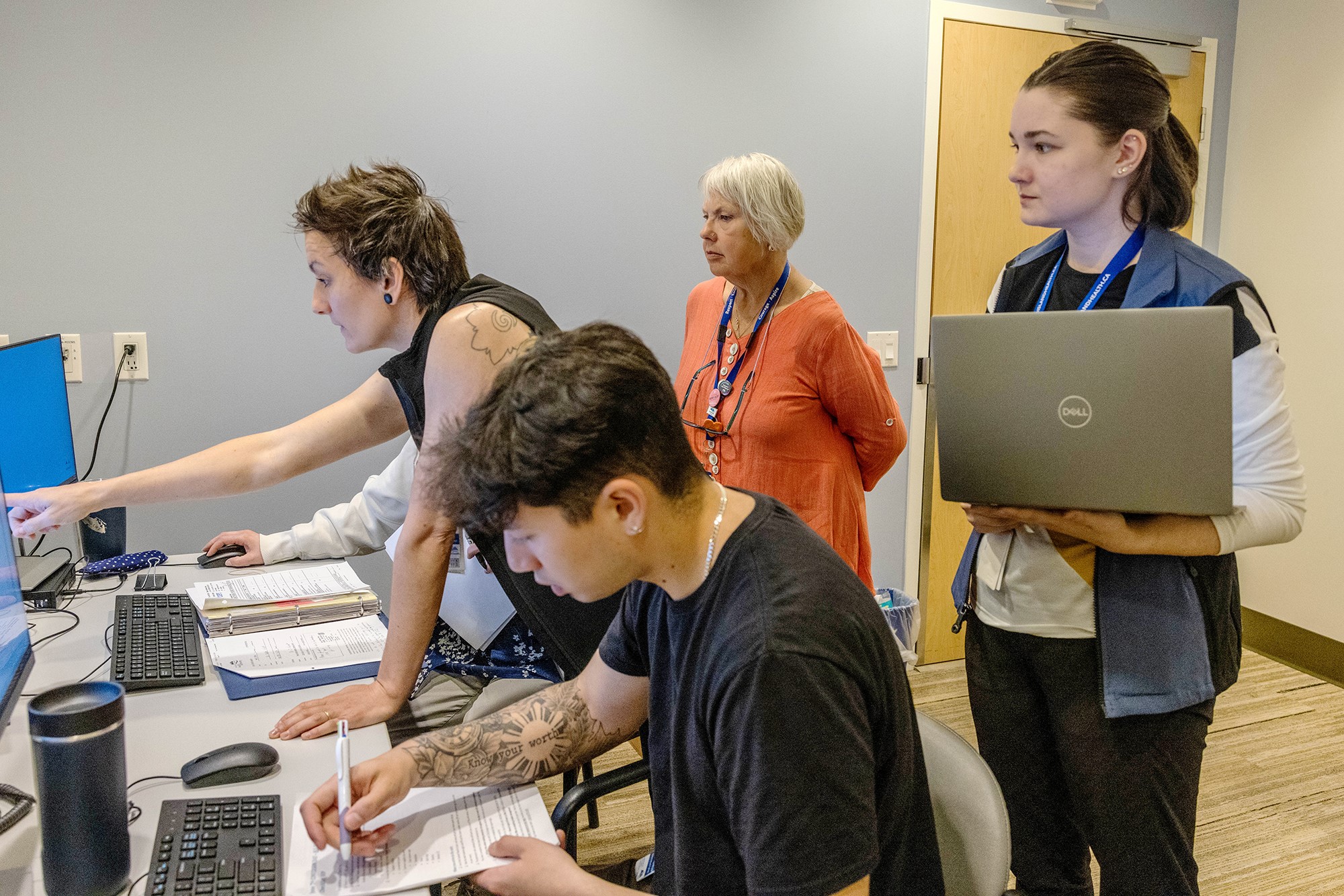 \
\Cutover to Go-Live: Bronwen LeGuerrier, RN (from left), Ben Villares, junior project analyst and co-op student, Suzanne Hare, RN, and Emily Clarke, project analyst participate in Clinical Cutover on the 5th Floor Med-Surg unit. Cutover is the process of moving information from paper charts to the electronic health record and began in these last few days before Go-Live. Cutover for each patient can take from a few minutes to over an hour, depending on complexity.
RJH Go-Live begins at 6 a.m. on June 8
Go-Live at Royal Jubilee Hospital (RJH) is now just hours away, beginning at 6 a.m. tomorrow, Saturday, June 8. Executive and site leadership has given approval to proceed with activation of computerized provider order entry (CPOE) and other advanced functions in the electronic health record (EHR). If you are working early on Saturday morning, listen for an overhead announcement that the system is live.
Find support at the elbow, on the desktop
There will be support when and where you need it as you begin using the system for the first time. If you need help or have a question, reach out 24/7 to support staff on your unit, use the “Band-Aid” tool at the top-right of your screen, or call IHealth Central Support at 1-855-755-7001 or 28555.
For more information, visit the Go-Live Resources page.
Thank you to RJH staff for your hard work, patience and dedication
Thank you to RJH staff and providers for the dedication, patience and hard work that have brought us to this day. Together we are taking a monumental step in our work that will positively impact the delivery of safe, consistent and quality care for our patients.
Interfacility transfers from June 8 - Sept 14
Between June 8 and September 14, transfers between RJH and VGH or RJH and GRH will be on a single encounter. During this time, staff and providers will need to:
Maintain the chart and prepare to send with the patient for transfers. Ensure medication administration documentation is up to date. Complete orders hygiene regularly to maintain an up-to-date record.
For more information and details specific to your role, go to the Interfacility Transfers pages on the Intranet.
If you need assistance, call 28555 and ask for the transfer support team.
Locations for new devices at RJH
Following a walk-through with site medical and clinical leaders, computers, printers, scanners and other devices were placed in strategic locations around RJH. They are available for use by staff for charting and electronic ordering on a first-come, first-served basis. See Additional Device Locations at Royal Jubilee Hospital for photos and details of the locations.